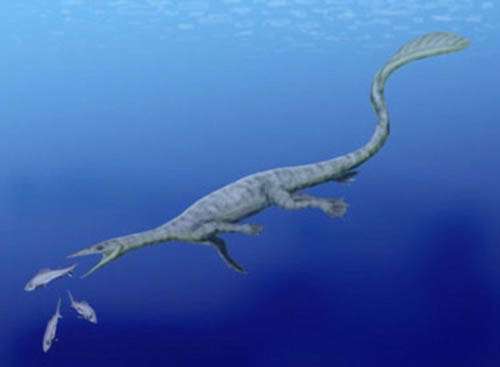A new thalattosaur found from the Upper Triassic of Guanling, Guizhou, China

Thalattosaurs, literally meaning "ocean lizard", are a group of prehistoric marine reptiles living during the Triassic Period in North America and Eurasia. They bore a superficial resemblance to lizards, but the exact relationships of thalattosaurs is unclear. Paleontologists from Institute of Vertebrate Paleontology and Paleoanthropology (IVPP), Chinese Academy of Sciences, and Zhejiang Museum of Natural History, described in detail a new species of thalattosaur, Concavispina biseridens, from the Upper Triassic (Carnian) Xiaowa Formation near Xinpu Village in Guanling County, Guizhou Province, China. The study published in the latest issue of Journal of Paleontology 87(2) provides important information regarding the biodiversity and the phylogenetic relationships of this group.
The Xiaowa Formation of Guanling is known for well-preserved marine reptiles and crinoids. Thalattosaurs are the most abundant and diverse group of these marine reptiles. Hundreds of nearly complete thalattosaur skeletons have been excavated, and four genera and six species have been described, making it the most diverse thalattosaur fauna in the world. Concavispina biseridens is a nearly complete skeleton with the tip of the rostrum missing, and it is the largest known thalattosaur in terms of absolute skull length. The skull is 50 cm long and the distance from the broken tip of rostrum to the anterior margin of the orbit is 252 mm.
Compared with other thalattosaurs, especially Xinpusaurus, Concavispina is characterized by a long skull, measuring approximately half the length of presacral portion of the vertebral column, two rows of blunt teeth on the anterior part of the maxilla, and neural spines that have convex anterior or posterior margins and V-shaped notches in their dorsal margins.

Concavispina differs from all thalattosaurs except Xinpusaurus in that the anterior end of the maxilla is curved dorsally, less than five cervical vertebrae are present, and the proximal end of the humerus is wider than the distal end.
Phylogenetic analysis, including all 14 species and 40 characters, suggests that Paralonectes is the most primitive member of Thalattosauridea, and Concavispina may form a clade with Xinpusaurus. Chinese thalattosaurs do not have a close relationship with eastern Pacific forms as suggested by previous studies.
Thalattosaurs have moderate adaptations to marine lifestyles, including long, paddle-like tails and slender bodies. Concavispina has a very short neck as ichthyosaurs, but it has a long tail with a laterally compressed appearance due to the presence of relatively high neural spines and long chevrons. Its limbs are short relative to the body, with short, wide epipodials and a poorly ossified carpus and tarsus. The animal probably relied on lateral undulations of the body axis for propulsion. The reduced limbs of Concavispina are less developed than those of Xinpusaurus, and were probably used for steering rather than propulsion. Additionally, the body is relatively shorter compared to the head in Concavispina, suggesting more limited propulsion power and poorer swimming ability.
Concavispina and Xinpusaurus probably had different diets. "The anterior teeth in Xinpusaurus are pointed and robust, while the posterior teeth are blunt and broad. In Concavispina the premaxillary teeth are pointed and slender, while the maxillary teeth are small, blunt, and anteriorly positioned. Xinpusaurus probably had the power to crush shells, while Concavispina could have eaten softer food such as fish and jellyfish", said study lead author Dr. LIU Jun of the IVPP.
More information: dx.doi.org/10.1666/12-059R1.1
Journal information: Journal of Paleontology





















